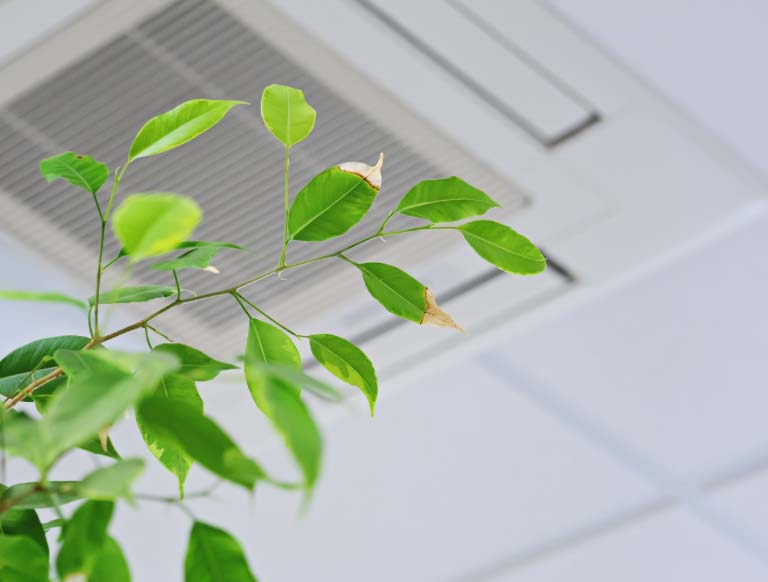Why you should be Monitoring Indoor Air Quality in Autumn
The System Hygienics guide explains the importance of monitoring and improving indoor air quality (IAQ) in autumn.

As the leaves begin to change colour and the air turns crisp, the importance of maintaining and monitoring indoor air quality (IAQ) cannot be overstated. The transition into autumn brings with it a unique set of challenges that can significantly impact the air we breathe indoors. With the cold and flu season on the horizon and the increased time spent indoors due to cooler temperatures, ensuring the health and safety of building occupants by monitoring IAQ becomes paramount.
The Impact of Colder Months on Indoor Air Quality
During the colder months, buildings tend to be sealed off more tightly to conserve heat. While this is effective for maintaining a comfortable indoor temperature, it can also trap pollutants, leading to degraded indoor air quality. Common indoor air pollutants include dust, mould spores, and volatile organic compounds (VOCs) from cleaning products or off-gassing from furniture and building materials. Without adequate ventilation, these pollutants can accumulate to levels that pose health risks to occupants.
The cold and flu season further complicates IAQ concerns. Viruses and bacteria can circulate more easily in poorly ventilated spaces, increasing the risk of transmission among building occupants. This is especially concerning in public buildings such as schools, offices, and healthcare facilities, where high occupancy levels can exacerbate the spread of illness.
The Value of Monitoring Indoor Air Quality in Autumn
Monitoring indoor air quality is critical to identifying and mitigating potential air quality issues before they escalate into health problems. Regular monitoring can help building owners and operators understand the levels of various pollutants within their buildings and take appropriate actions to improve air quality. This may involve adjusting ventilation rates, employing natural ventilation strategies, or using air-cleaning devices to reduce the concentration of airborne contaminants.
Moreover, monitoring IAQ can help ensure that ventilation systems are functioning correctly. As highlighted by BESA’s TR19, maintaining and cleaning ventilation systems is essential to providing adequate fresh air to indoor spaces and reducing the risk of airborne diseases. This is particularly important in autumn, as buildings begin to seal against the cold, and the demand for ventilation systems increases.
Steps to Improve Indoor Air Quality in Autumn
Building owners in the UK should take proactive steps to improve indoor air quality to combat the challenges posed by the colder months and the cold and flu season. This includes:
- Increasing Ventilation Rates: Ensuring that HVAC systems are set to provide an adequate supply of fresh air to dilute and remove contaminants.
- Natural Ventilation: Whenever possible, utilise natural ventilation by opening windows to allow fresh air to circulate, weather permitting.
- Reducing Indoor Pollution Sources: Identify and mitigate sources of indoor pollution, such as relocating printers to well-ventilated areas and minimising the use of harsh cleaning chemicals.
- Air-cleaning Devices: Consider using air purifiers with HEPA filters to capture airborne particles, including viruses and bacteria.
Responsibility for Indoor Air Quality
While the importance of monitoring and improving indoor air quality (IAQ) in autumn is evident, the question of who is responsible for these tasks can be less straightforward. Primarily, the responsibility often falls on building owners, who have ultimate control over the structure and its maintenance. However, it's essential to recognise that the responsibility for IAQ can also extend to others, including building managers and office managers.
Building managers play a crucial role in a building's day-to-day operations, making decisions that directly affect its indoor air quality. These individuals ensure that ventilation systems are properly maintained and operated to provide the occupants with fresh air. They also oversee the implementation of any necessary changes to improve IAQ, such as increasing ventilation rates or employing air-cleaning devices.
While perhaps not responsible for the building's physical maintenance, office managers still play a significant role in managing the environment within the office space. They can influence IAQ by regulating the use of cleaning chemicals, managing indoor plants, and even arranging the office layout to enhance natural ventilation. Additionally, office managers can advocate for IAQ improvements and work closely with building managers to implement them.
System Hygienics: Your IAQ Partner
For individuals or organisations prioritising a healthy, safe, and compliant indoor atmosphere, particularly as we brace for the colder seasons, reaching out to System Hygienics is necessary. This company stands out for its comprehensive services to enhance air quality within buildings. Their expertise spans a broad spectrum of areas, including but not limited to ventilation cleaning, extract cleaning, and fire damper testing.
What sets System Hygienics apart is its ability to ensure that your building meets all the pertinent health and safety regulations and its commitment to delivering a service that contributes significantly to the overall well-being and comfort of building occupants. By choosing their services, you're taking a step towards compliance with regulatory standards, investing in peace of mind, and fostering a healthier indoor environment. This becomes increasingly crucial as we transition into the colder months when indoor air quality can significantly impact health and comfort levels.
Their team of professionals is equipped with the knowledge, skills, and tools necessary to assess your building's air quality needs thoroughly. Following this, they provide tailored solutions that address any identified issues, ensuring that your premises are safe and conducive to the well-being of everyone who uses them. Whether it's routine maintenance or more specialised services, System Hygienics is dedicated to offering top-tier support in all aspects of air quality management.
Conclusion
As we embrace autumn, let us not overlook the importance of indoor air quality. The health and well-being of building occupants depend on our vigilance and commitment to monitoring and improving the air they breathe. By taking proactive measures now, we can ensure a healthier indoor environment that supports everyone's well-being, even as the colder months draw near.



